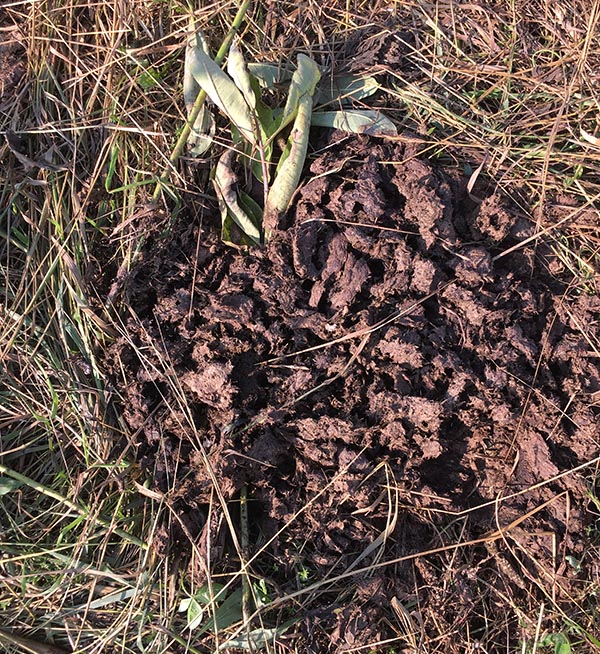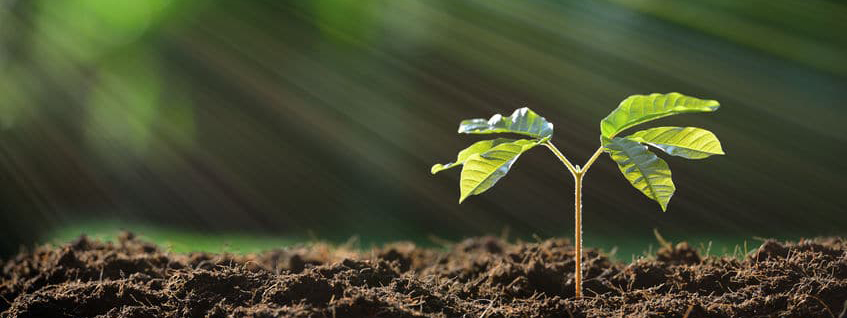by Morgan Hartman
While I’m new to Nature Works Organic Land Care, I feel like I’ve been a part of this company, or they’ve been a part of me, for years. Having the opportunity to work with such positive people, co-workers, and clients alike, who are interested in and actively working toward ecologically sound land care practices is amazing.
The basis of all we do is the stuff under our feet, the soil, and how we interact with it. It determines whether or not we have ecologically positive impacts through our landscape design and contracting business.
When I took my first soils and agronomy classes in the mid-90’s I learned about the importance of the geology beneath our feet. I learned the importance of high-quality soil structure and how to manipulate it physically and chemically through the addition of fertilizers and other amendments or through tillage toward prettier landscapes and higher yielding crops. But that was all really looking at soil as dirt, essentially an inorganic product of geological and chemical processes.
What was not taught so well, and maybe not even so very well understood by the faculty, was the biology in the soil that drives the Carbon cycle and how the Carbon cycle truly is the basis of all healthy, living soils (not to mention the basis of all life on Earth.) In short, the biological influences on soil structure, chemistry, and plants as a continuous, entirely connected system similar in many ways to skin or bark was not being taught. Soil biology includes the roots of plants, of course, but it also includes an incredible array of microbes (fungi, bacteria, and protists) as well as larger organisms like earthworms, dung beetles, nematodes, ants, termites, ad infinitum. The interactions between the microbiome in the soil with the mineral substrate, plant roots, and through the plants, their interactions with the animals above ground, especially ruminants are what keep our air and water clean.
Right now there is a growing interest in soil globally. Most of that interest is driven by the climate crisis we as a species have created for all species. Think of the devastation wrought in California and many other Western states last year by wildfires, or the wreckage in urban areas like Houston and NYC caused by Hurricane Harvey and Super Storm Sandy, respectively.
Often large-scale industrial agriculture practices and farmers catch the blame for the massive disruption to soil health which leads to both local and global catastrophes ranging from those fires and floods to water pollution in the Great Lakes, the Mississippi River, and of course, the world’s oceans. What does not often attract much notice in these discussions is the role urban and suburban development plays in disrupting the Carbon, Nitrogen, and water cycles.

Compaction of soils, and covering them with monocrop lawns, not to mention asphalt and concrete, leads to an inability of soils to absorb rainfall resulting in runoff and flooding, erosion of topsoil, and an absolute loss of resiliency to wet or dry conditions. We can mechanically aerate compacted soils, but that is inevitably a temporary bandaid on the problem of compaction which can only be more permanently alleviated by bringing our soils back to life and regenerating the Carbon cycle in our lawns, turf fields, golf courses and the like.
Fortunately, companies like Nature Works Organic Land Care have taken on the mission of restoring the Carbon cycle one lawn, one residential landscape at a time by utilizing Organic practices which promote plant species diversity in our clients’ lawns and gardens. Some of those practices are obvious; using only Certified Organic compost, chicken litter, lime, and other products which promote healthy biota in the soil, as opposed to poisoning everything but the Kentucky blue grass turf.
Another practice which we engage in is promoting species diversity by not mowing so closely to the soil surface and allowing “weeds” to live side by side with the grass plants in the lawns we manage. We also look to use as many native plants as possible in our garden designs broadly representing grasses, legumes, forbs, and a wide array of trees and shrubs. By intentionally creating diverse plant communities in the landscapes we work on, we are in effect making the soil microbiology more diverse.
A newer area of study within the soil science and agronomy universe is the role plant root exudates play in building up communities of microorganisms in the soil. A root exudate is a cocktail of sugars and proteins which different plant species exude from their roots to feed beneficial communities of bacteria, fungi, and protists. In turn, these microorganisms multiply by feeding on these compounds and feed on soil organic matter. This process breaks down organic compounds into inorganic forms which the plants can utilize, it is called soil mineralization.
When we fertilize our plants with inorganic forms of the macronutrients nitrogen, phosphorous, and potassium, we inadvertently kill off the beneficial soil microbiology that lives in symbiosis with plants. Our landscape plants become addicted to these inorganic soil amendments because their symbiotic partners have been supplanted by what we humans have supplied. This becomes a series of compounding, cascading effects leading to ever greater degradation of our soils through the loss of pore space and ever-increasing compaction.
One of the many other things soil microbes do is create “glues”, like the compound glomalin, which hold soil particles together, but do so in a matrix of aggregates with pore space. Well aggregated soils do two important things really well. They absorb/drain surface water away and can actually release stored water slowly. Think of a big piece of moist chocolate cake. It is crumbly, but fluffy, not dense. Milk flows well into that piece of chocolate cake making for a delicious bite full of both milk and cake, a winning combination.
The other important aspect of this pore space in soil is its ability to move air deep into the root zone of plants where both the plant and its associated microbial partners can live aerobically. Good root and microbial respiration in this kind of environment diminishes the ability of many disease-causing microbes to live. In other words, healthy soil conditions act to prevent damaging or lethal infections.
The net result of healthy soils with diverse communities of microbes, plants and animals is a more resilient garden or lawn. This resilience can be seen in the form of green grass and other plants during a drought when your neighbor’s lawn and garden are brown and crusty. Similarly, during extended wet periods, your lawn and garden will continue to thrive while the neighbor’s is turning yellow or becoming diseased.
If we take this concept to a local, regional, or even global scale we see balance return not only to natural communities, but also to human communities. Our decisions and actions in our lawns and gardens can have profound effects and the law of compounding, cascading effects can work in a positive, healthy direction just as easily as it works in a negative direction. Think of the positive effects on an entire neighborhood when soil health is considered and promoted by all or even the majority of homeowners. There is less runoff going into the sewage or drainage system of a city or town. There are fewer nutrients ending up in streams, rivers, and lakes which prevents die-off of fish and other animal populations. When flood waters rise, they dissipate much more quickly on healthy soils than on compacted, dead soils, and those flood waters create far less damage. When fires rage through desiccated areas only to come upon an entire locale of healthy soils and green plants, the damage is lessened because healthy, moist plants don’t burn as readily as the desiccated ones. Because of those positive effects of healthy soils, we can have healthier, more resilient human communities.
It is for these reasons I, for one, am glad to be working for and with the Nature Works community of employees and clients. I really want to emphasize the word community.
For reference, please visit the following websites:


